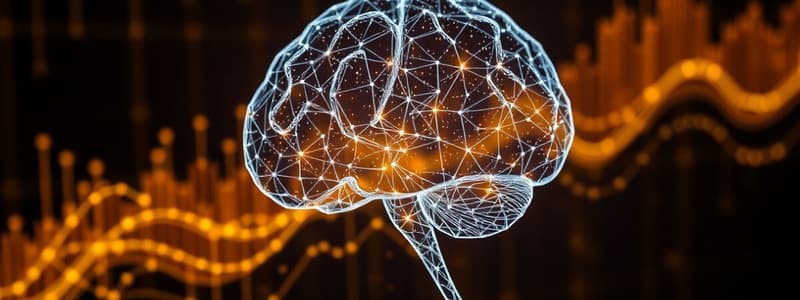Podcast
Questions and Answers
Machine Learning algorithms can help simplify code for complex problems.
Machine Learning algorithms can help simplify code for complex problems.
True (A)
Machine learning is exclusively useful for problems with existing solutions.
Machine learning is exclusively useful for problems with existing solutions.
False (B)
Online learning systems learn incrementally from data.
Online learning systems learn incrementally from data.
True (A)
In reinforcement learning, the system is trained with a labeled dataset.
In reinforcement learning, the system is trained with a labeled dataset.
In batch learning, the system is capable of learning incrementally.
In batch learning, the system is capable of learning incrementally.
Machine Learning can only be used with a traditional approach.
Machine Learning can only be used with a traditional approach.
Semi-supervised learning uses only labeled data.
Semi-supervised learning uses only labeled data.
The most important factor for Machine Learning is the type of algorithm.
The most important factor for Machine Learning is the type of algorithm.
Machine Learning requires labelled data.
Machine Learning requires labelled data.
In supervised learning, training data includes the desired solutions, called labels.
In supervised learning, training data includes the desired solutions, called labels.
Linear Regression is an example of an unsupervised learning algorithm.
Linear Regression is an example of an unsupervised learning algorithm.
K-Means clustering is a supervised learning algorithm.
K-Means clustering is a supervised learning algorithm.
A spam filter classifying emails as spam or not spam is an example of regression.
A spam filter classifying emails as spam or not spam is an example of regression.
Instance-based learning involves building an explicit model from the training data.
Instance-based learning involves building an explicit model from the training data.
Machine Learning can learn from data.
Machine Learning can learn from data.
Flashcards
What is Machine Learning?
What is Machine Learning?
The science of programming computers so they can learn from data.
Why use Machine Learning?
Why use Machine Learning?
Simplifies code, performs better, and adapts to new data.
Supervised Learning
Supervised Learning
ML systems trained with human supervision.
Unsupervised Learning
Unsupervised Learning
Signup and view all the flashcards
Semi-Supervised Learning
Semi-Supervised Learning
Signup and view all the flashcards
Reinforcement learning
Reinforcement learning
Signup and view all the flashcards
Batch Learning
Batch Learning
Signup and view all the flashcards
Online Learning
Online Learning
Signup and view all the flashcards
Instance-Based Learning
Instance-Based Learning
Signup and view all the flashcards
Model-Based Learning
Model-Based Learning
Signup and view all the flashcards
Classification
Classification
Signup and view all the flashcards
Regression
Regression
Signup and view all the flashcards
Clustering
Clustering
Signup and view all the flashcards
Anomaly Detection
Anomaly Detection
Signup and view all the flashcards
Generalization
Generalization
Signup and view all the flashcards
Study Notes
Machine Learning
- Machine Learning (ML) is a field where computers are programmed to learn from data
- ML enables computers to learn without explicit programming
- A computer program learns from experience (E) regarding a task (T) and performance measure (P)
- Performance on T, measured by P, improves with experience E
Why Use Machine Learning?
- ML is used instead of traditional programming for spam filters
- Traditional spam filters require writing detection algorithms for patterns in spam emails
- The program flags emails as spam based on detected patterns
- These steps are repeated until the program performs to a sufficient degree
- ML can automatically adapt to changes over time, such as new spam techniques
Uses for Machine Learning
- ML is useful for problems that require extensive hand-tuning or long lists of rules
- One such Machine Learning algorithm simplifies code while improving performance
- ML is used for complex problems without good solutions using traditional approaches
- The best Machine Learning techniques find solutions for these hard problems
- ML is used for fluctuating environments, where a Machine Learning system adapts to new data
- ML is used for complex problems and large amounts of data to gain insights
Types of Machine Learning Systems
- They can be classified based on various criteria
- ML systems can be classified based on training with human supervision
- Supervised
- Unsupervised
- Semi-supervised
- Reinforcement Learning
- ML systems can be classified based on whether they learn incrementally
- Online versus batch learning
- ML systems can be classified based on how they work
- Comparing new data points to known data points
- Detecting patterns and building a predictive model
- Instance-based versus model-based learning
Supervised Learning
- ML systems are classified according to the amount and type of supervision they get during training
- Supervised learning includes training data fed to the algorithm that includes the desired solutions
- A typical supervised learning task is classification, such as a spam filter that learns to classify new emails
- Another task is predicting a target numeric value based on predictors; this is called regression
Supervised Learning Algorithms
- k-Nearest Neighbors
- Linear Regression
- Logistic Regression
- Support Vector Machines (SVMs)
- Decision Trees and Random Forests
- Neural networks
Unsupervised Learning
- Unsupervised Learning involves training data that is unlabeled
- Algorithms:
- Clustering
- K-Means
- DBSCAN
- Hierarchical Cluster Analysis (HCA)
- Anomaly detection and novelty detection
- One-class SVM
- Isolation Forest
Semi-Supervised Learning
- Semi-supervised learning deals with partially labeled training data
- It usually involves a lot of unlabeled data with a little bit of labeled data
Reinforcement Learning
- Reinforcement Learning is a very different system
- An agent observes the environment, selects, and performs actions
- The agent can get rewards in return (or penalties in the form of negative rewards)
- The agent learns by itself the best strategy (aka a policy) to get the most reward over time
- A policy defines what action the agent should choose in a given situation
Batch and Online Learning
- Another criterion to classify ML systems is whether or not they can learn incrementally
- Batch learning systems can not learn incrementally
- It is trained using all available data and is typically done offline
- Online learning trains the system incrementally by feeding it data instances sequentially
- Learning steps are fast and cheap, so the system can learn about new data on the fly
Instance-Based vs Model-Based Learning
- ML systems can be categorized by how they generalize
- This involves making predictions based on instance-based training examples
- Instance-based learning means the system needs to generalize to previously unseen examples
- The true goal is performing well on new instances
- Two main approaches to generalization are instance-based learning and model-based learning
Instance-Based Learning
- Instance-based learning entails a system learning examples by heart
- It then generalizes to new cases by comparing them to the learned examples
Model-Based Learning
- Build a model from a set of examples
- Use that model to make predictions
- This is called model based learning
Main Challenges of Machine Learning
- Select a learning algorithm and train it on some data
- Issues include "bad algorithm" and "bad data"
- Insufficient Quantity of Training Data
- Nonrepresentative Training Data
- Poor Quality Data
- Irrelevant Features
- Overfitting the Training Data
- Underfitting the Training Data
- Stepping Back
- Testing and Validating
Studying That Suits You
Use AI to generate personalized quizzes and flashcards to suit your learning preferences.



